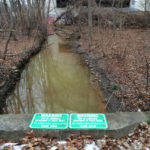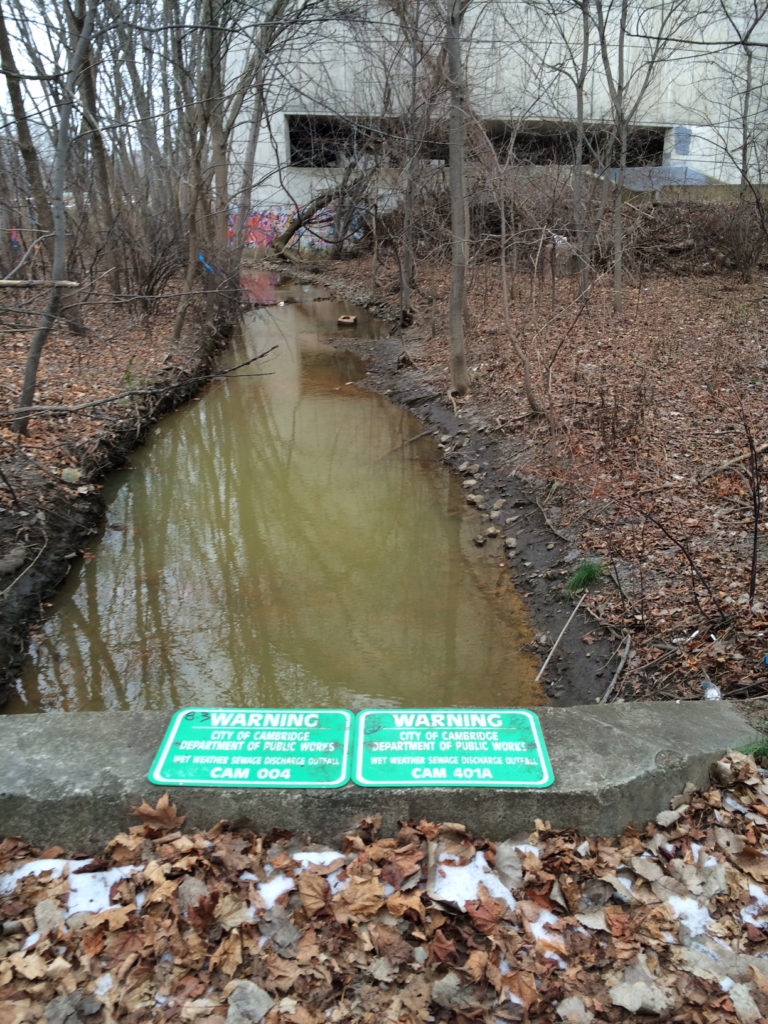
Discharges to Alewife Brook Have Persisted for Two Decades
By Kristin Anderson and David White
Fifty million gallons of sewage-contaminated stormwater have been discharged into the Alewife Brook from the cities of Cambridge and Somerville in 2021, according to websites for those two cities and the Metropolitan Water Resources Authority (MWRA) for the Alewife/Upper Mystic Combined Sewer Overflow (CSO). There has been as much sewage-contaminated water discharged into the Alewife Brook in 2021 as there was in 1997 before the implementation of a $200 million plan to modernize the area’s antique combined sewer systems.
Pollution persists in the Alewife sub-watershed because the area, already prone to flooding, is densely developed with impervious surfaces including pavement, rooftops, and sidewalks. To make the matter worse, during major flood events when the Mystic River rises, it flows backward into the Alewife Brook, reversing the brook’s direction. This conveys the contaminated flood water containing untreated sewage back upstream through vulnerable neighborhoods in East Arlington and North Cambridge, into the Little River and Belmont, and into residents’ homes, yards, and parks. The situation is expected to get worse due to climate change.
Sewage discharges continue for decades
The reported 2021 discharge volume shows no reduction in the volume of discharge compared to the base year of 1997. That’s the year that the MWRA chose as the standard in its original Long Term CSO Control Plan (LTCP) to reduce the amount of combined sewage discharge in the Alewife/Upper Mystic River Basin.
What is a CSO?
A combined sewer overflow (CSO) is the discharge of untreated sewage mixed with stormwater into local waterways. These overflows happen when heavy rains or snow melt overwhelm a sewer system where sewage and stormwater pipes are connected. Normally, these pipes send sewage to the Deer Island treatment plant, but when they overflow, sewage flows out through the stormwater pipes into rivers and brooks like the Little River and Alewife Brook.
Cambridge and Somerville have been sending untreated sewage mixed with stormwater directly into the Alewife Brook through sewer outfalls. An outfall is a pipe or conduit that carries stormwater (sometimes combined with raw sewage) into a body of water. These sewers, relics of combined sewer systems from the 19th century, are known as “one-pipe systems.”
The combined sewer system carries stormwater, industrial wastewater, and untreated domestic sewage away in a single pipe out to the Deer Island water treatment plant. This one-pipe system is often overwhelmed during and after storms, when a mix of untreated sewage and stormwater is discharged, via outfalls, directly into the Alewife Brook. Rains, tides, and river currents then carry the pollution to Boston Harbor via the Mystic River.
As a result of the landmark Conservation Law Foundation Boston Harbor cleanup court case in the 1980s, the Environmental Protection Agency (EPA) enforced the Clean Water Act and required that the CSO pollution end. The Clean Water Act created federal standards for discharges of pollution. The Massachusetts Legislature then created the MWRA to manage and modernize the Boston water and sewer system, including creating the new sewage treatment facility at Deer Island. It was determined that the cost of totally replacing the existing CSO system would be very expensive and burdensome to the ratepayers, especially in less affluent communities. Thus a political compromise was made to only do part of the work.
The 12-year plan to fix CSOs
For the Little River-Alewife Brook watershed, the plan was to eliminate half of the Alewife CSOs and construct a wetland in Alewife Reservation to clean some of the discharge. According to the DEP’s 2019 Alewife Mystic Final Variance Fact Sheet, the initiative to close and control the CSOs promised the public an 85% reduction in sewage pollution while satisfying the DEP requirement that improvements were being made. The LTCP split this work into seven large projects which took more than a dozen years to complete. All of this work was finished by 2015.
In 2015, victory was declared at a ribbon-cutting ceremony at the newly created Alewife Reservation Constructed Wetland in North Cambridge. This celebratory event marked the completion of the first LTCP for remediating the CSOs. Cambridge had good reason to celebrate: this project is a rare example of cutting-edge bioengineered green infrastructure.
The wetland collects stormwater from Cambridge’s Huron Village neighborhood, north to Fresh Pond Parkway. The stormwater is pumped from the surrounding commercial and residential areas into a holding tank known as a “forebay,” where sediment is allowed to settle before the water is released into the wetland to be biologically filtered for contaminants and then conveyed into the Little River just above where it becomes the Alewife Brook at the Minuteman Trail footbridge.
To many people, this beautiful park appears to be an urban wild, with its trails, 119,000 native plantings, great blue herons, ducks, swans, eels, and other wildlife. But it is so much more than that. The wetland provides flood relief and reduces sewage pollution via bioremediation while helping to protect Cambridge’s water supply at Fresh Pond. Constructed wetlands are tertiary treatment systems that use natural processes involving wetland vegetation, soils, and their associated microbial assemblages to improve water quality, according to the EPA.
It is hard to imagine how much worse off the area would be without the excellent work that was completed in 2015.
Pollution persists today
How is it possible that in 2021, after all the work that was done to reduce the CSO discharges, that we are now experiencing the same volume of hazardous pollution as we did before making any investments in green and gray infrastructure?
It has been a wet year, but that cannot completely explain the fact that the CSO activations are six times worse than the original LTCP promised. Sometimes just one inch of rain can activate a CSO in the Alewife Brook.
Is the rate at which the rain fell in 2021 to blame for the unexpectedly large volume of CSO discharge? Is it because the ground absorbs less water, as developers continue to build one new building in the area after the next, with impervious rooftops, impervious access roads, and impervious parking lots?
How is it possible that we are now experiencing the same volume of hazardous pollution as we did before making any investments in green and gray infrastructure?
Is it that new developments are tied into the combined sewer system lines, further reducing system capacity? Is it due to the vanishing trees and vegetation which normally used to slurp up groundwater as the roots aid infiltration and send the rainwater into the water table (where it becomes a resource rather than a waste product)? Are we experiencing more storms because of climate change?
The answer is probably a combination of these factors, but it is clear that we are losing ground. We must continue the work of modernizing the sewer systems and employing green infrastructure and other nature-based solutions or the problem will get worse.
Improvements have to be made to reduce the damaging impact of the CSOs. There have been no investments since that ribbon-cutting ceremony in 2015. But there is now an opportunity to create a second Long Term Control Plan, which we will call LTCP2.
LTCP2 should include everything that was part of the first LTCP:
- Sewer separation
- Closing of the remaining Alewife Brook outfalls
- Green infrastructure including bio basins, bioswales, planter boxes, rain gardens, permeable asphalt roads
- A holding tank for stormwater with extra capacity to help relieve flooding
- Another bioengineered wetland park with trails and native plantings
This plan would take a big step towards climate change resiliency.
In addition to sewer infrastructure upgrades, necessary improvements in the Mystic River must be made to reduce flooding. An important key to controlling Alewife area flooding is the proper operation, maintenance, and upgrades at the Amelia Earhart Dam. Looking into the future, if the Amelia Earhart Dam is breached or flanked during future storms, a surge of water will be pushed up the Mystic into the Alewife Brook and into the neighborhoods of our most vulnerable populations.
A review of FEMA flood maps reveals there are an estimated 1,200 East Arlington residents, 3,500 Cantabrigians, and 300 Belmont residents living in the Little River-Alewife Reservation’s 100-year floodplain. This number does not count the 643 residents living in housing on the former Belmont Uplands/Silver Maple Forest site, who would be completely stranded and surrounded by water in the event of a 100-year flood.
There will likely continue to be flooding in some extreme events, but antique combined sewer systems make flooding much worse by contaminating floodwaters with raw sewage. We can close the outfalls. Six have already been closed on Alewife Brook, and there are six more to go.
Topography and flooding
For the Mystic River and Alewife Brook, topography is destiny. Both streams are below the mean high-tide level of Boston Harbor and have historically been tidal, with the water flow direction changing with the tide. For many years, this tidal flow was used to power mills.
Because of pollution and malaria concerns, the river flows were changed in 1909 with the construction of the Craddock Dam and tidal gates at Medford Center. This dam was replaced in 1966 by the Amelia Earhart Dam and pumping station at the mouth of the Mystic that pumps water into the harbor as needed to maintain a predictable water level.
The Amelia Earhart Dam is the key to reducing flooding in the Mystic River and Alewife Brook. If the Mystic rises too high, water can flow backward in Alewife Brook towards Cambridge and Belmont. With global warming and sea-level rise, this dam will have to be reinforced to continue to protect the Mystic and the Alewife.
Kristin Anderson is an Arlington Town Meeting member whose home was occupied by the untreated sewage flood waters of the Alewife Brook during more than one 100-year flood event within a two-year period. David White is an Arlington conservation commissioner who has been involved in environmental activities for many years.



Sorry, the comment form is closed at this time.